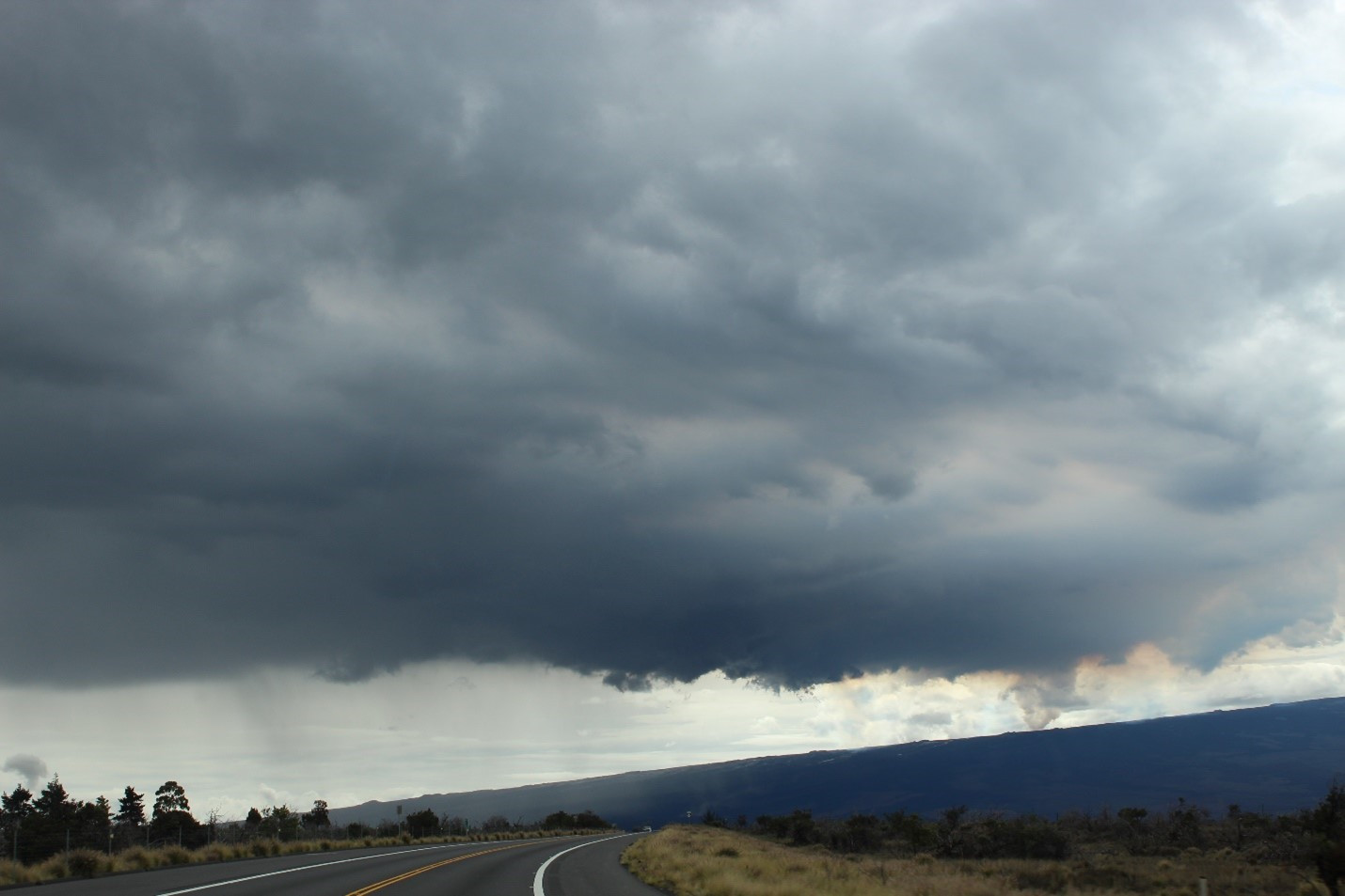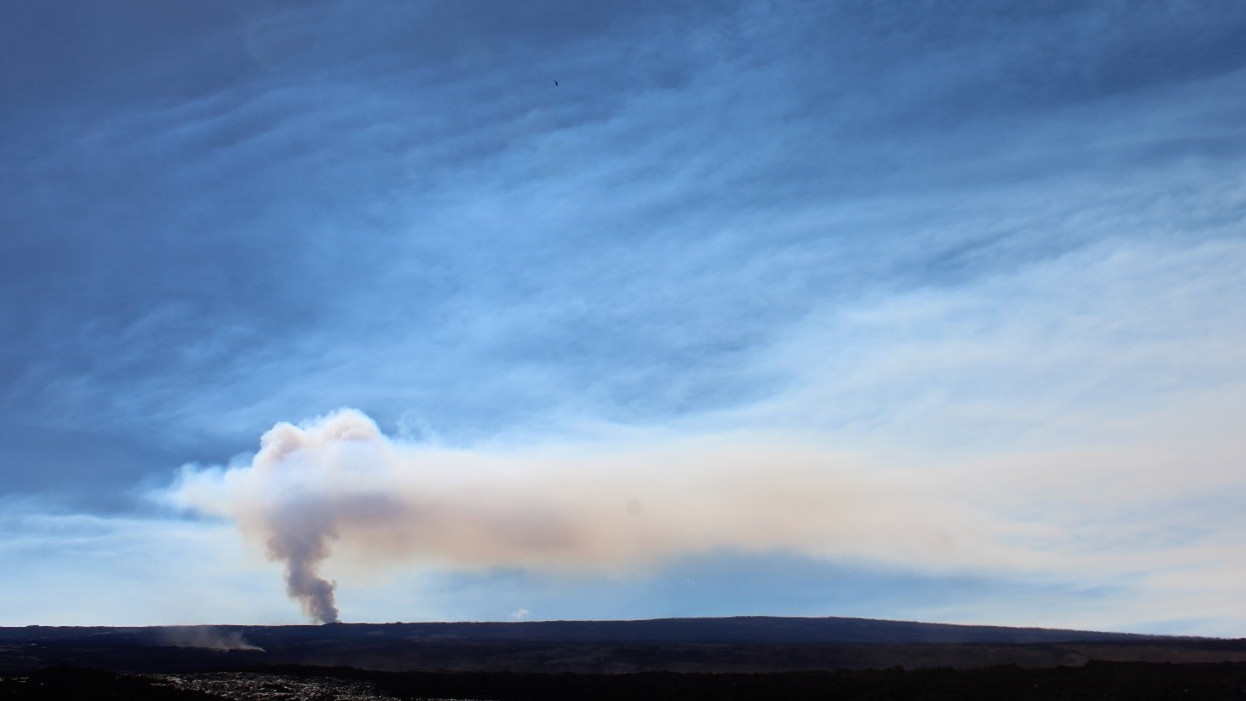
USGS: “Mauna Loa’s Fissure 3 gas plume, with rain clouds, as seen from the Saddle Road on November 29, 2022. The orange-brown tint near the vent is due to scattering by aerosols in the plume. The dark gray clouds are a mix of plume with what are called pyrocumulus clouds, or clouds that the volcano itself generated via the intense heating of the air by the erupting fissure.” (USGS photo by M. Warren)
(BIVN) – Mauna Loa is not erupting, and shows no signs of activity. “Seismicity remains low,” the USGS wrote recently. “Deformation rates show inflation somewhat above background levels, but this is not uncommon following eruptions.”
Scientists also say sulfur dioxide (SO2) emission rates are currently at background levels. This was not the case during the November 2022 eruption, however. That is the topic of this week’s Volcano Watch article, written by USGS Hawaiian Volcano Observatory scientists and affiliates:
When Mauna Loa erupted in November 2022 for the first time in nearly forty years, one of the main concerns was the lava and where it would flow. But Mauna Loa didn’t only erupt lava – as with all other volcanic eruptions, many tonnes of volcanic gases were emitted from the active vents.
Volcanic gases emitted during eruptions include water vapor, carbon dioxide (CO2), and sulfur dioxide (SO2). During eruptions, the Hawaiian Volcano Observatory (HVO) aims to characterize both the chemistry and amount of gas being emitted.
SO2 emission rates are a key parameter to measure, as they can be used as a proxy for lava effusion rate and they dictate how much vog, or volcanic air pollution, there is downwind. Typically, we measure SO2 emission rates using a vehicle-mounted ultraviolet spectrometer, which we drive beneath the plume.
At Kīlauea, because the trade winds tend to blow the summit plume in a single direction, we have a permanent array of spectrometers to measure SO2 there, so we don’t have to do as much driving. Driving on Chain of Craters Road for the Puʻuʻōʻō eruption and on Highway 130 for the 2018 lower East Rift Zone eruption were our common means of measuring the plume in the trade wind direction for these other Kīlauea eruptive sites.
Mauna Loa, however, at such a high altitude compared to Kīlauea, experiences different wind patterns, and winds were very variable during the eruption. Sometimes measurements of high-altitude plumes can be made relatively easily by flying an airplane or a helicopter beneath the plume instead of driving. However, the Mauna Loa plume had not only high concentrations of gases, but also contained particles, like Pele’s hair, which could adversely affect an aircraft flying under it.
So what did that mean for the HVO gas crew during the eruption? We had to shift gears and do a whole lot of driving!
Over the course of the roughly two-week eruption, the winds took the plume in many directions, including over Saddle Road, Ocean View, Pāhala, Puna, Hilo, Kailua-Kona, and Captain Cook. This meant that the HVO gas team drove nearly 3,000 miles (4,800 km) in total! Ultimately, all the driving paid off and we succeeded in measuring emission rates on ten separate days. This allowed HVO to report these emission rates to the public and to vog forecasters during the eruption.
Preliminary data processing suggests that Mauna Loa emitted over two million tonnes (2 Mt) of SO2 between November 28 and December 12. This doesn’t include a large volume of SO2 that satellite images show was emitted with the initial fissure opening overnight between the 27th and 28th of November; we need ultraviolet light to make these driving measurements, which means they can only be conducted during daylight hours.
Daily emission rates are estimated to have ranged from 200,000 to 500,000 t/d of SO2 early in the eruption and were just over 100,000 t/d later in the eruption. By December 8, emissions had dropped significantly to only about 30,000 t/d. Only about 2,000 t/d were emitted on December 10, and by December 12, emissions were essentially not detectable, even on the ground near the Fissure 3 cone.
These emission rates are very similar to those measured during the 2018 lower East Rift Zone eruption at Kīlauea, which also emitted SO2 at a rate of nearly 200,000 t/d for a portion of the eruption. The total SO2 emitted by the 2018 eruption was roughly five times more than Mauna Loa’s total, however, owing in part to the longer eruption duration.
SO2 emission rates reported for the 1984 eruption of Mauna Loa were roughly 100,000 to 200,000 t/d, as derived from satellite data. However, the technology used at the time was not as sophisticated as our modern spectrometers and likely underestimated those emission rates. So Mauna Loa’s 1984 SO2 emissions were probably similar to those in 2022.
SO2 emission rates at Mauna Loa’s Fissure 3 are down to nearly zero with the eruption being over. Mauna Loa will eventually erupt again and when it does, HVO’s gas team will be in the driver’s seat, ready to do whatever it takes to measure emission rates.
The USGS Volcano Alert Level for Mauna Loa is at ADVISORY.


by Big Island Video News8:02 am
on at
STORY SUMMARY
HAWAIʻI ISLAND - The high-altitude gas emissions during the November 2022 eruption of Mauna Loa meant a lot of driving for scientists trying to take measurements.